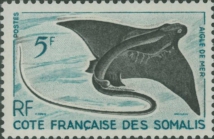MSBIAS taxon details
Myliobatidae Bonaparte, 1835
Myliobatinae Bonaparte, 1835 · unaccepted > superseded rank
- Genus Myliobatis Cuvier, 1816
- Subfamily Mobulinae Gill, 1893 accepted as Mobulidae Gill, 1893 (unaccepted > superseded rank)
- Subfamily Myliobatinae Bonaparte, 1835 accepted as Myliobatidae Bonaparte, 1835 (unaccepted > superseded rank)
marine, brackish, terrestrial
Not documented
Froese, R. and D. Pauly. Editors. (2024). FishBase. Myliobatidae Bonaparte, 1835. Accessed through: The UK Marine Environmental Data and Information Network (2024) Marine Species of the British Isles and Adjacent Seas (MSBIAS): a checklist of species derived from the UNICORN and Marine Recorder applications at: https://www.marinespecies.org/msbias/aphia.php?p=taxdetails&id=105710 on 2024-10-24
The UK Marine Environmental Data and Information Network (2024). Marine Species of the British Isles and Adjacent Seas (MSBIAS): a checklist of species derived from the UNICORN and Marine Recorder applications. Myliobatidae Bonaparte, 1835. Accessed at: https://www.marinespecies.org/MSBIAS/aphia.php?p=taxdetails&id=105710 on 2024-10-24
Date
action
by
taxonomy source
Van Der Laan, R.; Eschmeyer, W. N.; Fricke, R. (2014). Family-group names of Recent fishes. <em>Zootaxa.</em> 3882(1): 1-230., available online at https://doi.org/10.11646/zootaxa.3882.1.1 [details] Available for editors 
context source (PeRMS) Chirichigno, N.; Cornejo, M. (2001). Catálogo comentado de los peces marinos del Perú. <em>2ª ed. Instituto del Mar de Perú. Publicación Especial. Callao.</em> 314 p. [details]
basis of record van der Land, J.; Costello, M.J.; Zavodnik, D.; Santos, R.S.; Porteiro, F.M.; Bailly, N.; Eschmeyer, W.N.; Froese, R. (2001). Pisces, <B><I>in</I></B>: Costello, M.J. <i>et al.</i> (Ed.) (2001). <i>European register of marine species: a check-list of the marine species in Europe and a bibliography of guides to their identification. Collection Patrimoines Naturels,</i> 50: pp. 357-374 (look up in IMIS) [details]
additional source Fricke, R., Eschmeyer, W. N. & Van der Laan, R. (eds). (2024). ECoF. Eschmeyer's Catalog of Fishes: Genera, Species, References. <em>California Academy of Sciences. San Francisco.</em> Electronic version accessed dd mmm 2024., available online at http://researcharchive.calacademy.org/research/Ichthyology/catalog/fishcatmain.asp [details]
context source (PeRMS) Chirichigno, N.; Cornejo, M. (2001). Catálogo comentado de los peces marinos del Perú. <em>2ª ed. Instituto del Mar de Perú. Publicación Especial. Callao.</em> 314 p. [details]
basis of record van der Land, J.; Costello, M.J.; Zavodnik, D.; Santos, R.S.; Porteiro, F.M.; Bailly, N.; Eschmeyer, W.N.; Froese, R. (2001). Pisces, <B><I>in</I></B>: Costello, M.J. <i>et al.</i> (Ed.) (2001). <i>European register of marine species: a check-list of the marine species in Europe and a bibliography of guides to their identification. Collection Patrimoines Naturels,</i> 50: pp. 357-374 (look up in IMIS) [details]
additional source Fricke, R., Eschmeyer, W. N. & Van der Laan, R. (eds). (2024). ECoF. Eschmeyer's Catalog of Fishes: Genera, Species, References. <em>California Academy of Sciences. San Francisco.</em> Electronic version accessed dd mmm 2024., available online at http://researcharchive.calacademy.org/research/Ichthyology/catalog/fishcatmain.asp [details]
 Present
Present  Inaccurate
Inaccurate  Introduced: alien
Introduced: alien  Containing type locality
Containing type locality
| Language | Name | |
|---|---|---|
| English | manta rayseagle rays | [details] |

